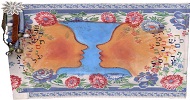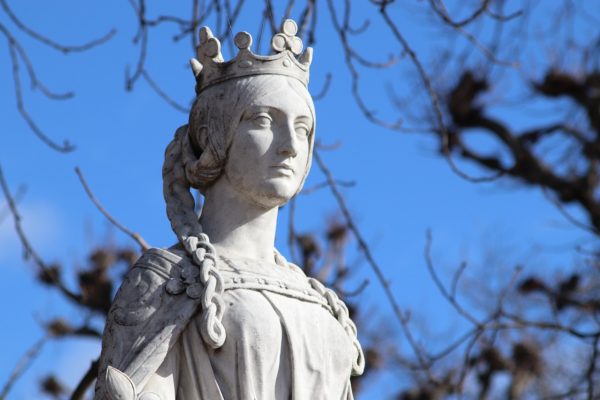Megillat Esther has been understood as a fantasy of Jewish power written in a time of Jewish powerlessness. But the megillah actually tells two parallel stories. The primary story is about how Jews in the Diaspora became victims to the whims of power, and then, in the “happy” conclusion, the victors. The secondary story, a story about women and men, follows a similar course, beginning with a wife who is banished when she refuses to obey her husband and concluding with a wife who is listened to and given a significant amount of power. In both stories edicts are issued that threaten the rights of an entire group – Jews and women. Both edicts are eventually subverted through the cunning and courage of Esther and Mordecai. Yet, only one of these subversions is celebrated in our communal observance of Purim.
With the new ritual of waving Esther/Vashti Purim flags, we encourage our communities to celebrate and more deeply explore both of Purim’s stories. Purim thus becomes both a celebration of and reflection on Jewish pride and perseverance and an opportunity to honor women’s power in the face of those who fear it.
The central ritual of Purim is the reading of the megillah. During the megillah reading we call attention to Haman, the story’s villain, through the spinning of gragers intended to drown out his name. We highlight the role of Mordecai by joining with the entire congregation in reciting four verses of the megillah out loud. These verses introduce Mordecai (Esther 2:5), accentuate the moment of his parading before the king in royal apparel (8:15-16) and tell of his new role as deputy to the king at the conclusion of the story (10:3). These two customs – the grager and the recitation of the four verses – serve to ritually emphasize the characters of Haman and Mordecai as the central actors of the story.
Currently, the rituals and symbols associated with Purim do not evoke either Esther or Vashti. At least symbolically, the fact that the grager and its noise are the prominent symbols and sounds of Purim serve to put Haman, hatred, and sometimes valorization of violent retribution at the center of communal celebrations of Purim. Even though the purpose of the grager is to drown out Haman’s name, in actuality it reifies his presence in the sanctuary. Synagogue is a place where both children and adults are usually called to listen. Suddenly, on Purim we are allowed, even encouraged, to make so much noise that a certain word will not be heard. The commandment on Purim is to listen to every word of the megillah, but the custom of the grager often threatens that commandment, especially because the drowning out is more fun than the listening. Compared to the shofar (ram’s horn) which we are commanded to listen to on Rosh Hashanah and which serves as a symbol of awakening, gathering, and proclaiming freedom, the grager is a negative sound. It is the opposite of listening.
In contrast, the primary purpose of the Purim flag is to call attention to Esther and Vashti and make it fun to listen for their names. But the Purim flag offers us an opportunity to do more than balance our attention to men’s names with attention to women’s names; it does more than allow us an opportunity for some feminist fun. When we wave our flags at the mention of Vashti and Esther’s names we begin to shift the focus of Purim. No longer do we need to accept that the opposition of “blessed Mordecai” and “cursed Haman” encompasses the story of Purim or the story of Jewish experience. By focusing on Vashti and Esther, as well as Haman and Mordecai, we open up the possibility of telling a more complete and complex Purim story, a story that includes the experiences of women and a story that honors the possibility of potential alliances between Jews and non-Jews.
By placing Esther and Vashti on the same flag, we are also challenging ourselves to move beyond the dichotomy of bad queen/good queen (and good feminist/bad feminist) and embrace a wider spectrum of possibility for women’s leadership. For much of Jewish interpretive tradition, Vashti was the bad queen and Esther the good one. Then, in the early days of Jewish feminism, Vashti was resurrected and celebrated for her open defiance of the king and her powerful defense of her body and sexuality. Not surprisingly, as Vashti’s popularity grew, Esther fell out of favor. Feminists were not sure they could accept two different models of powerful women. For some, Esther suddenly became a negative symbol for all women who use their sexuality, enjoy their beauty, fear confrontation, and remain married to power. These interpretations of Esther minimized her courage in directly confronting both Ahasuerus and Haman, and in “coming out” as a Jew after years of hiding her identity. They also ignore Esther’s powerful role as an innovator of communal ritual action in her calling for a public fast.
With these Purim flags we hope to move away from the paradigms of good ‘girl’/bad ‘girl’ and good feminist/bad feminist to explore – through art and our experience of it – the relationship between Esther and Vashti and all that they have come to symbolize. Celebrating Vashti along with Esther also gives us a ritual-means to balance the antagonism inspired by Haman with a celebration of how much we have to gain by listening and not simply blotting out. Vashti is not evil like Haman or a fool like Ahasuerus. She is a non-Jewish woman who because of her own suffering at the hands of the more powerful has much in common with both Mordecai and Esther and can therefore serve, on a narrative and symbolic level as a teacher, model and ally.
I began this essay by pointing out that Megillat Esther has been seen as a fantasy of Jewish power that emerged in a time of Jewish powerlessness. We who read the megillah in a time of unprecedented Jewish power both in the State of Israel and in the United States, are thus in need of ritual ways of wrestling with the megillah in order to figure out its meaning for our time. As feminists committed to honoring Esther’s leadership, we cannot ignore the fact that it is Esther who asks the king for an additional day on which the Jews can kill their enemies – “the armed force together with women and children” (Esther 8.11, 9.13). While we proudly wave a flag bearing her name, we must challenge ourselves to find a way to celebrate Esther’s power without necessarily endorsing the violence she authorizes. Perhaps this is another reason for our pairing of Esther and Vashti – once we link the stories of this Jewish and non-Jewish queen we are on the way to recognizing the linked fates of their peoples. When we unite Esther who ends up as a powerful queen with Vashti who by the end of the story is absent and therefore powerless, we can begin to grasp the necessity of balancing the need to exercise power with the need to share it.
It is time for us to make room in our myths and in our communities for more than one model of leadership. It is time for us to learn from both Esther and Vashti, from both the Jewish women in our texts and the non-Jewish women (and men). It is time to celebrate women’s power and to question the ways we have wielded it over others. And, with humor and deep conviction, it is time for us to take the holiday of Purim and, through new ritual, use it to tell our community a new story about who we are, what we value, and what we need to do to build a better world. I thank all the creative artists who participated in this exhibition for being like Esther and “coming forth when their light was needed in the world.”1
This article was first published in Ma’yan’s exhibition catalogue, A Different Purim Sound: Waving Flags and Ringing Bells, An Exhibition of Esther and Vashti Purim Flags by Jewish Artists. Photo: Facing Ourselves, Judith Margolis.












